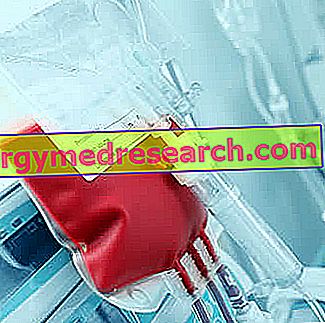PROTAPHANE ® a drug based on human isophane insulin
THERAPEUTIC GROUP: Human isophane insulin for injectable use - insulins and analogues
IndicationsAction mechanismStudies and clinical effectiveness Usage and dosage instructionsWarnings Pregnancy and lactationInteractionsContraindicationsUndesirable effects

Indications PROTAPHANE ® - Human isophane insulin
PROTAPHANE ® is indicated for the treatment of insulin-dependent diabetic pathology and gestational diabetes.
Mechanism of action PROTAPHANE ® - Human isophane insulin
The isophane insulin contained in PROTAPHANE ® is an analogue of human insulin obtained in the laboratory from Saccaromices Cerevisiae and complexed with protamine sulfate.
As it is known, the pharmacokinetic properties of insulin are essentially associated with the route of administration and the mode of drug release, in this case they are dependent on the presence of protamine, and which allow the isophane to act in about 90 minutes reaching the maximum activity between the fourth and twelfth hours to extend to the twenty-fourth hour.
In a manner very similar to the endogenous hormone, the exogenous insulin reaches the insulin-sensitive tissues such as adipose and muscle tissue through the circulatory stream, increasing the uptake and utilization of blood glucose, directed towards glycolysis, glycogen synthesis and lipogenesis.
At the same time, the hypoglycemic effect of insulin is also expressed through the modulation of hepatic metabolic activities, useful for reducing the production and secretion of endogenous glucose.
Studies carried out and clinical efficacy
1. INSULIN THERAPY IN THE SECOND TYPE DIABETIC PATIENT
In more severe cases of second-type diabetes mellitus, oral hypoglycemic therapy is not able to produce good glycemic control by exposing the patient to serious risks. In this study it has been shown that the administration of intermediate insulin such as the isophane can quickly lead to good glycemic control, significantly reducing the concentrations of glycosylated hemoglobin.
2. MEDICAL DEVICES: ADVANTAGES AND DIFFICULTIES.
If the marketing of easy-to-use medical devices for the diabetic patient such as pens or pre-filled cartridges has greatly simplified the life of the diabetic patient, it is also true that the incorrect preparation can alter the normal therapeutic properties of the drug preventing good glycemic control. It is therefore useful to reiterate the importance of doctor-patient communication, necessary to optimize the effectiveness of the therapy.
3. INSULIN THERAPY AND INFLAMMATORY MARKERS
It is known as meals especially when excessive can induce an inflammatory response to the intestinal level, in many cases imposing. In this study it was demonstrated how isophane insulin, although it differs significantly on post-prandial glycemic control compared to insulin aspart, can still guarantee a significant reduction of inflammatory markers in the immediate post-prandial period.
Method of use and dosage
PROTAPHANE ® 100 IU / ml of human injectable insulin 3ml cartridges or 3 ml pre-filled pens:
although an optimal therapeutic range of between 0.5 - 1 IU / kg per day for first type diabetic patients and 0.3 - 0.6 IU / kg per second type diabetic patients can be indicated, the correct dosage can only be formulated by the doctor according to the conditions pathology of the patient and his glycemic control.
PROTAPHANE ® can also be combined with regular or rapid insulin taken during main meals.
Isophane insulin injection should be performed subcutaneously at the level of the thigh or abdomen, preferably at scheduled times and repeatable daily.
Warnings PROTAPHANE ® - Human isophane insulin
The drug therapy with insulin should be preceded and accompanied by periodic monitoring of the glycemic values, the patient's state of health and his dietary habits.
Adjustments of the insulin dosage could be necessary, even during therapy, in order to guarantee a good glycemic control and avoid metabolic decompensation, even serious ones such as hypoglycemic crises.
Moreover, given the frequency of this collateral event, it is advisable that the patient can recognize early the warning symptoms and consequently resort to timely remedies able to prevent the worsening of the clinical picture.
Episodes of hypoglycemia often are accompanied by a reduction in the patient's reactive and perceptive capacities, making it dangerous to use machinery and drive vehicles.
PREGNANCY AND BREASTFEEDING
Gestational diabetes is a condition that affects about 3% of pregnant women and that if badly compensated can seriously affect the development and health status of the fetus.
Insulin today represents the only therapeutic support able to guarantee a good glycemic control whose therapeutic activity is well characterized.
Interactions
The simultaneous intake of oral hypoglycemic agents, octreotide, anti-MAO, beta-blocking agents, ACE inhibitors, salicylates, alcohol and anabolic steroids could potentiate the therapeutic effect of PROTAPHANE ®, significantly increasing the risk of hypoglycemia.
On the contrary, the concomitant administration of oral contraceptives, thiazides, glucocorticoids, thyroid hormones and sympathomimetics could reduce the hypoglycemic effect of isophane insulin, requiring a possible adjustment of the dosage.
It is also useful to remember that sympatholytics can mask some important signs of hypoglycemia, increasing the risk of serious reactions.
Contraindications PROTAPHANE ® - Human isophane insulin
PROTAPHANE ® contraindicated in case of hypoglycemia and hypersensitivity to human insulin or its excipients.
Undesirable effects - Side effects
Clinical studies and careful post-marketing monitoring show how insulin therapy can be associated with the incidence of both local and systemic side-effects episodes.
Among the local adverse effects it is in fact possible to describe some of them of a transitory nature such as redness, pain and itching at the injection site and others with a chronic course such as lipoatrophy during inoculation.
Disorders at the gastro-intestinal level, visual problems and systemic hypersensitivity reactions, represent some of the less frequent and more transient systemic reactions, while the risk of hypoglycaemia and its symptomatology is decidedly more important.
Note
PROTAPHANE ® sold only under medical prescription.
PROTAPHANE ® falls into the doping class: Hormones and related substances (prohibited in and out of competition)



